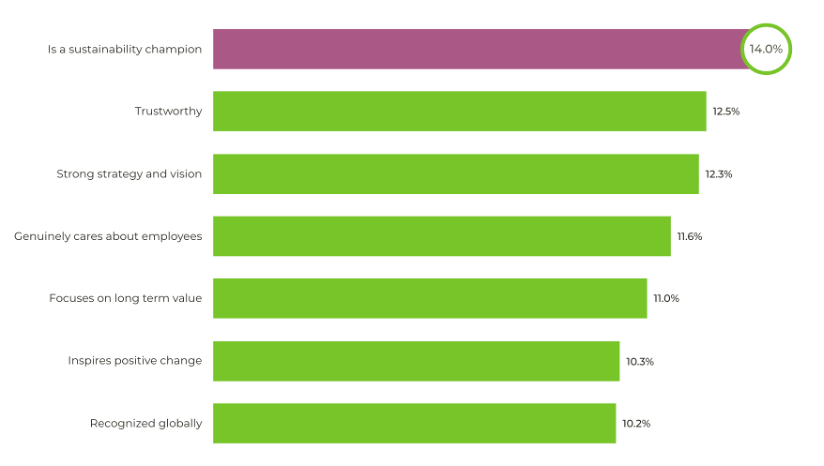When Brand Perception meets ESG: The Emerging Sustainability Value Gap
Consumers value brands that engage in ethical practices and demonstrate concern for societal and environmental issues. Brands perceived as environmentally and socially responsible often enjoy stronger consumer loyalty and trust, producing higher returns and rise in share price.
Sustainability Perception Value
A Brand Finance study illustrates that Apple currently holds the highest sustainability perception value of any brand, valued at $33.3 billion. This ranking reflects perception rather than actual sustainability performance. Consumers seem to trust that Apple is making enough efforts to reduce its environmental impact, which encourages continued use of its services.
However, this should not lead to complacency. Consumer expectations can shift due to increased media scrutiny, evolving reporting standards, and growing awareness of sustainability issues. If Apple fails to continuously improve its sustainability practices and communicate its progress openly, this perceived value could be in jeopardy.
Gap Analysis
Many brands are at risk of a disconnect between perceived sustainability and actual performance. By re-evaluating brands using ESG consensus data, it becomes clear where perception and reality diverge.
Brands with stronger performance than perception have a chance to boost their value by effectively communicating their real sustainability efforts. Brands with higher perception than performance are at immediate risk of losing value, as they could face public backlash and a correction in their sustainability image.
Ultimately, brands that excel in sustainability must communicate their efforts clearly to unlock additional value, while those with overinflated perceptions need to improve their actual performance to avoid reputational damage and a loss in perceived value.
Tesla: A Sustainability Perception Risk
Tesla is widely recognized as a trailblazer in electric vehicles and battery technology, with key innovations driving the transition to a lower-carbon economy. This pioneering image has significantly shaped global consumer perceptions. As a result, Tesla holds one of the highest proportions of its brand value driven by sustainability perceptions (23.4%), equating to a sustainability perception value of $13.7 billion.
However, the strength of this perception also presents risks. While Tesla performs well in environmental aspects of sustainability, it faces challenges in areas like governance and social sustainability. In 2022, S&P removed Tesla from its ESG index, citing concerns over labour practices at its Fremont factory, issues with its code of business conduct, and its handling of a National Highways Transportation Safety Administration investigation. As a result, Tesla's potential value at risk is $1.5 billion.
Microsoft: A Sustainability Opportunity
In contrast, Microsoft has the largest positive gap in sustainability perception, with a potential value gain of $3.16 billion, according to Brand Finance’s research. This suggests that Microsoft’s actual sustainability performance exceeds consumer perceptions. By improving communication about its sustainability efforts and services, Microsoft has the opportunity to unlock additional value.
This contrast between Tesla and Microsoft highlights the importance of not only performing well in sustainability but also managing the balance between perception and actual performance to mitigate risk and maximize brand value.
Sector Sustainability Driver Scores
Sustainability plays a significant role for many premium auto brands, not just Tesla. In the luxury auto sector, where 23.8% of consumer choices are influenced by sustainability, brands traditionally associated with high fuel consumption increasingly rely on their environmental reputation. In this segment, where purchases are aspirational and highly visible, sustainability becomes even more crucial for maintaining brand appeal and consumer trust.
Sustainability heavily influences consumer choices in sectors like soft drinks (14.9%), IT services (14.1%) luxury cosmetics (11.4%), supermarkets (11.1%) and Media (11.1%). Consumers are particularly aware of environmental issues like plastic pollution, deforestation and food miles in these sectors, while cosmetics brands enhance their appeal by promoting the natural and ethical attributes of their products through sustainability messaging.
Sustainability is the key driver of CEO reputation
In addition to gathering consumer opinions and sentiments, the Brand Guardianship Index (below) evaluates the perceptions of top CEOs. The 2024 findings reveal that sustainability emerged as the leading factor influencing CEO reputations.
Sustainability disclosure mandates for businesses in the UK and EU
National governments are increasingly enforcing reporting requirements for businesses headquartered or operating within their borders, following established frameworks. Previously, this was largely focused on climate-related guidance.
Now, the focus has expanded to full ESG (Environmental, Social and Governance) disclosures, driven by the EU’s Corporate Sustainability Reporting Directive (CSRD). This directive replaces the Non-Financial Reporting Directive (NFRD) and sets a legal foundation for mandatory sustainability reporting. The CSRD aims to standardize reporting practices and integrate sustainability with financial reporting, affecting over 50,000 companies.
ESG and its future impact on advertising
Brands that are leaders in sustainability must clearly communicate their efforts to unlock maximum value. With the UNSDGs deadline approaching, both companies and investors are increasingly prioritizing ESG initiatives. This shift will impact advertising strategies and the media investment supply chain, especially through agencies. The key question is: Has your brand or agency started taking these steps yet?




